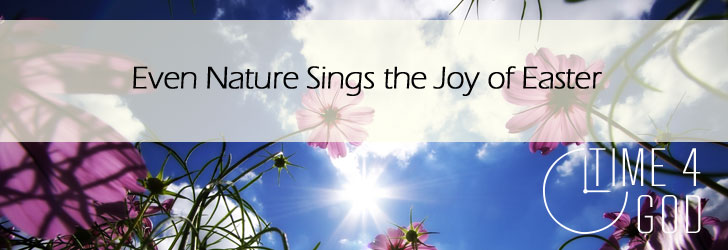
Easter joy is in the air all around us. The flowering trees are heavy with bright blossoms, daffodils are everywhere, and the birds are busy building nests and singing their hearts out. It seems the whole of nature is infused with the joy of Easter too.
As a former teacher of literature, I worked on a daily basis with the literary tools of metaphor and simile, of symbolism and theme. We can read the book of nature for all of these things too. Spring, for example, is a profound symbol for resurrection. Winter, with its naked trees, its dark, rain-heavy skies, its cold blankets of snow, and its shortened days here in the northern hemisphere, is a powerful symbol of death and dying for us. Theologically, winter can be used as a powerful symbol of sin and its effects on the living soul. Yet, the soul, being an eternal creature, desires the light, the light of forgiveness, and of the new life it brings. And each year winter comes. And each year spring is not far behind. The long wait from Adam to Jesus was our winter. The life of Jesus enters its winter in his passion and death on the cross. But, to our inexpressible joy, Easter and resurrection come as surely as the spring does every year.
[content-ad]
After the long winters we grow anxious for spring. We are psychologically ready to be rid of the doldrums and the darkness of winter. So it is with our hearts and souls. Easter is God’s promise to us. Though there is darkness in life and certainly in our deaths, we are assured by the cross and the resurrection that our souls will experience the promise of spring. Only this time, spring will last forever.
We are destined to be people of Spring. The flowers, the sweet songs of the birds, the new green leaves in the trees are all simple, beautiful symbols of what God has in store for us. The Easter egg, that has become such a common symbol of a now commercialized and secularized celebration of Easter, is a strong symbol of death and resurrection. The egg dies to itself and the chick rises from the tomb of the shell to a life in the light of the sun and the wind. The butterfly that begins to flutter in the new spring, through the sun-laden meadows, or in the house garden, is a wonderful symbol of death and resurrection. What was once a lowly, slow-moving, and ugly worm, ʺdiesʺ into its chrysalis, then is born again with bright, beautiful wings and the freedom of flight.
Poets, writers, artists, composers, have been moved by these powerful symbols of death and resurrection from time immemorial. Metaphor, simile, symbol, and theme, are all devices used in literature and in the arts to move the mind from the immediate to the transcendent. Spring speaks to us of the joy of Easter. Spring lifts our spirits from the immediate beauties it gives birth to, to transcendent thoughts of the God of creation. Though death has reigned since Adam, because of Jesus, death has been conquered and the beautiful Spring of the Garden of Eden, the heavenly kingdom, has been open to us once again—forever. See, we are people of Spring. We are Easter People. We are the Children of God. The eternal Spring sun that will never set, has risen on us. Let us, then, imitate the joyous songs of the birds of spring. Let us shout our joy to all who will listen. We can take the poetic words of Percy Bysshe Shelley in his poem, ʺOde to the West Wind,ʺ for their ultimate, Easter meaning now, ʺIf Winter comes, can Spring be far behind?ʺ Hallelujah! He is Risen! Our long winter is gone.
SKM: below-content placeholderWhizzco for FHB

